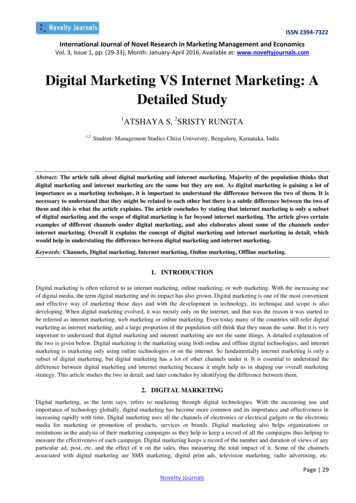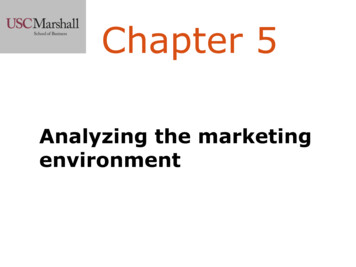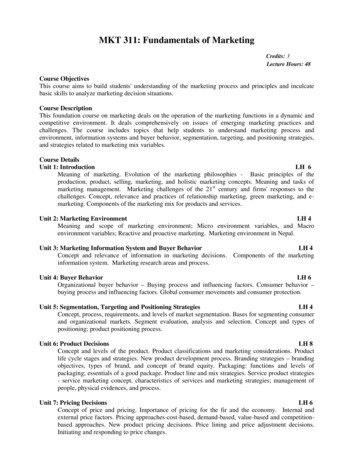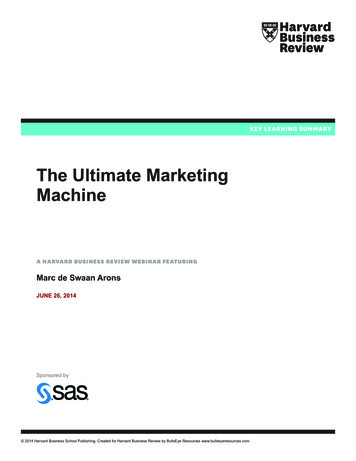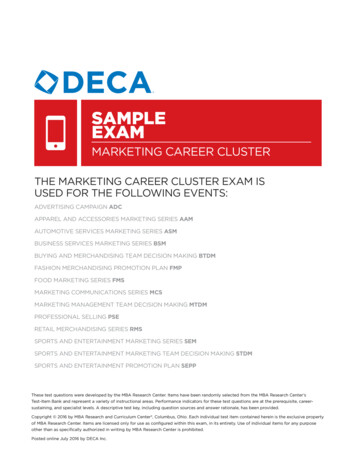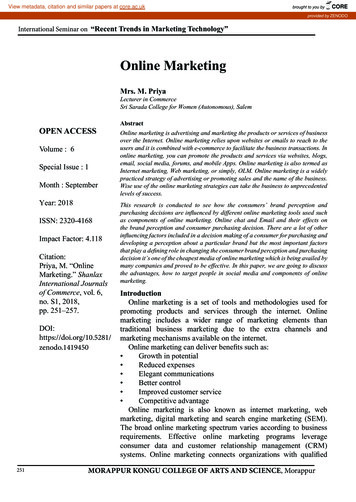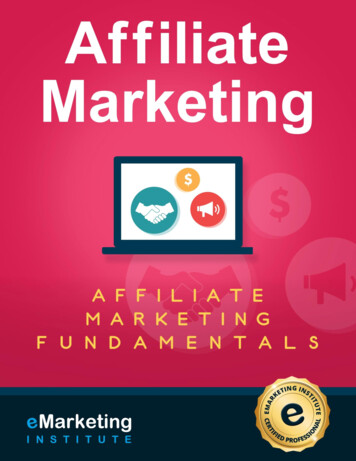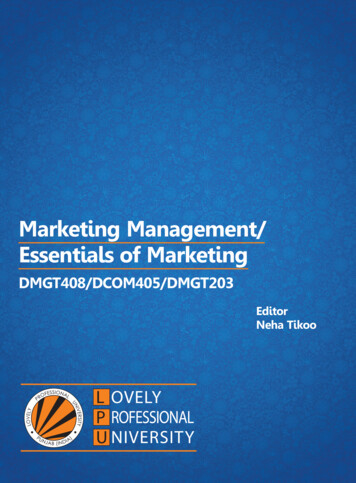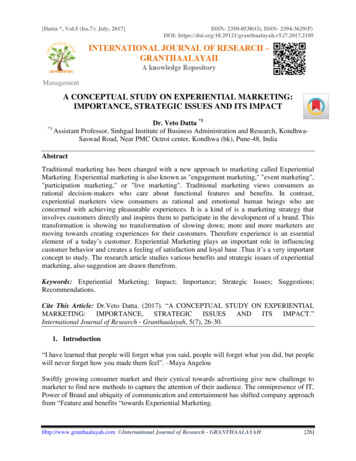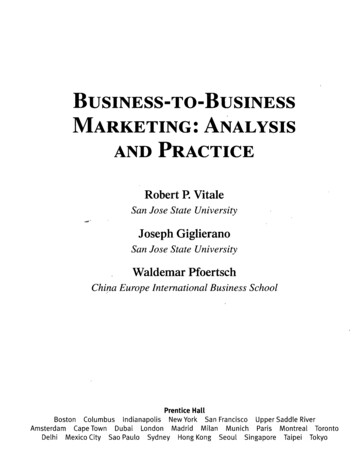
Transcription
BUSINESS-TO-BUSINESSMARKETING: ANALYSISAND PRACTICERobert P. VitaleSan Jose State UniversityJoseph GiglieranoSan Jose State UniversityWaldemar PfoertschChina Europe International Business SchoolPrentice HallBoston Columbus Indianapolis New York San Francisco Upper Saddle RiverAmsterdam Cape Town Dubai London Madrid Milan Munich Paris Montreal TorontoDelhi Mexico City Sao Paulo Sydney Hong Kong Seoul Singapore Taipei Tokyo
CONTENTSForeword xxviiPreface xxixAcknowledgmentsxxxiChapter 1 Introduction to Business-to-Business MarketingIntroduction 31Marketing Fundamentals in Business-to-Business Markets 3The Marketing Mix 4PRODUCTPRICEPLACE456PROMOTION7Marketing Philosophy and Culture 7Further Differences Between Business Marketing and ConsumerMarketing 8Derived Demand and Business-to-Business Supply Chains 8 **'THE BULLWHIP EFFECTVOLATILITY811Complexity—A Rationale for Relationship MarketingOPPORTUNITIES THROUGH RELATIONSHIPS1213Market Structure 13Integrated versus Networked Supply, Brand Identity 14Some International Considerations 15An Examination of Value 18The Value Chain 19Direct versus Support Activities 20Misunderstanding of the Value and Value Chain Concepts 21Trends and Changes in Business Marketing 22HYPERCOMPETITION22FORMATION OF PARTNER NETWORKS23ADOPTION OF INFORMATION TECHNOLOGY AND THE INTERNETSUPPLY CHAIN MANAGEMENTTIME COMPRESSION24Thoughts to Take with You into the Next ChapterKey Terms 25Endnotes 262323 24Questions for Review and Discussion 25IX
ContentsChapter 2 Business-to-Business Environment: Customers,Organizations, and Markets 28Introduction 30Practical Application of Market GeneralizationsTypes of Organizational Customers 31Commercial Enterprises 31INDUSTRIAL DISTRIBUTORS31VALUE ADDED RESELLER'S31ORIGINAL EQUIPMENT MANUFACTURERSUSERS OR END USERS303232Government Units 33Nonprofit and Not-for-Profit Organizations33Producer Types 33RAW MATERIALS PRODUCERS33COMPONENT PARTS AND MANUFACTURED MATERIALS PRODUCERSCAPITAL GOODS MANUFACTURERSCUSTOMER SPECIFICATIONS343435Customer Needs Influenced by Classification of Markets 35Classifying the Business-to-Business Market Environment 35Publics 35FINANCIAL PUBLICSINDEPENDENT PRESS3636PUBLIC INTEREST GROUPSINTERNAL PUBLICS3637The Macroenvironment37THE DEMOGRAPHIC ENVIRONMENTTHE ECONOMIC ENVIRONMENT3738THE SOCIOCULTURAL ENVIRONMENTTHE NATURAL ENVIRONMENT3838THE TECHNOLOGICAL ENVIRONMENTTHE COMPETITIVE ENVIRONMENT3939Usefulness of Classification 41Value Networks and Supply Chains 41Supply Chain Management as a Form of Value NetworkManagement 43Using the Value Network and Supply Chain Concepts 43VALUE NETWORKS AND COMPETITION44Changes in Markets Over Time 44The Product Life Cycle 45The Technology Adoption Life Cycle 47BRIDGING A CHASM47ACROSS THE CHASM AND INTO THE TORNADO48
ContentsThoughts to Take with You into the Next ChapterKey Terms 50Endnotes 51 50Questions for Review and Discussion 50Chapter 3 Organizational Buying and Buyer Behavior 52Introduction54The Nature of Buying 55The Consumer Buying Decision Process 55Organizational Buying 55The Buying Center 56Organizational Buyers' Decision Process: A Stepwise Model58Intricacies of the Buying Decision Process 58INDIVIDUAL ROLES AND PERSONAL NEEDS58THE BUYING PROCESS IS SIMULTANEOUS, NOT SEQUENTIALRELATIONSHIPS AND LOYALTYTHREE KINDS OF NEEDS585959CLUSTER OF STAKEHOLDERS' VALUES59Organizational Buyers Decision Process: A ProcessFlow Model 59.Stage 1: Definition60THE MEANING OF A SPECIFICATION61THE SPECIAL CASE OF AN INTEGRATED SUPPLY CHAIN62Stage 2: Selection 63DISTINCTION FROM PUBLIC SECTOR PURCHASING64BUYERS SEEK SELLERS WITH BEST TOTAL OFFERING AND CAPABILITIESStage 3: Solution Delivery, SUPPLY CHAIN IMPLICATIONS6566Stage 4: Endgame 66Two Examples of Buying Decision Processes 66Discussion of Examples 67Transition of Buying Decision Process—New Task BecomesRebuy 70Influences that Shape the Buying Decision Process 71Other Organizational Influences 72Other Interpersonal and Individual Influences 72Implications for Business Marketing 72The Variability of Rational Buying Decisions 73Human Factors in Business Decisions 73Mutual Dependence and Customer Loyalty 74A Brief Psychology of this Process 74APPLICATION IN BUSINESS RELATIONSHIPS7564xi
xiiContentsThoughts to Take with You into the Next ChapterKey Terms 77Endnotes 78 76Questions for Review and Discussion 77Chapter 4 The Legal and Regulatory EnvironmentIntroduction 80Business Regulation in a Free Market7981Enforcement Responsibilities 81The Legislative Acts that Affect MarketingSherman Antitrust Act (1890) 8282Clayton Act (1914) 83Federal Trade Commission Act (1914)83Robinson-Patman Act (1936) 85Celler-Kefauver Act (1950) 85Consumer Goods Pricing Act (1975) 85Securities Laws 86Sarbanes-Oxley Act and Its Offspring 86The Uniform Commercial Code 86Business Legislation Issues 87Intercorporate StockholdingInterlocking DirectoratesPrice Maintenance 87Refusal to Deal 898787Resale Restrictions 89Price Discrimination 89Quantity Discounts 92Substantiality Test 94Company Size 95Some International Implications 95FOREIGN CORRUPT PRACTICES ACT (FCPA) 95BASIC PROVISIONS OF THE FCPA96Supply Chain Implications 96Intellectual Property 96Antitrust Implications of Intellectual PropertyCross Licensing 98Joint Ventures 99Confidentiality Agreements 99Political Framework of EnforcementPacific Drives Revisited 10010097
ContentsThoughts to Take with You into the Next Chapter 100Key Terms 101 Endnotes 102Questions for Review and Discussion 101Chapter 5 Concepts and Context of Business Strategy 103Introduction 104What is Strategy? 105Strategy-Making and Strategy Management Processes 107Performing Strategic Management in the Business-to-BusinessCompany 107A Critique of the Model 110Key Strategy Concepts 111Strategic Resource Allocation 112Strategic Business Unit Management 112Tools for Designing Strategy 113The Growth-Share Matrix 114RETHINKING THE MATRIX115Multifactor Portfolio Matrix116INCOMPATIBILITY OF CULTURES WITHIN ORGANIZATIONS"PORTFOLIOS AND VALUE117117The Balanced Scorecard 118Taking an Entrepreneurial Approach to Marketing Strategy 118The Organization Mission 119FOSTERING OWNERSHIP119Changing the Rules 120Special Issues in Business Strategy 120Strategy Implications of Value Networks and,IntegratedSupply Chains 120Strategy Development and the Internet 120Strategic Implications of Market Ownership 121Strategy Development in New Businesses 121Thoughts to Take with You into the Next Chapter 122Key Terms 122 Endnotes 123Questions for Review and Discussion 122Chapter 6 Market Research and Competitive Analysis 124Introduction 126Market Research 127Market Research Fundamentals 128DEFINE THE PROBLEM AND RESEARCH OBJECTIVES129DESIGN THE RESEARCH METHOD TO ACHIEVE THE RESEARCH OBJECTIVES129xiii
uxivContentsCOLLECT THE DATA130ANALYZE THE DATA AND DRAW CONCLUSIONSPRESENT THE FINDINGS130130Implications of Types of Decision SupportRESEARCH TO SUPPORT TARGETING DECISIONSRESEARCH TO SUPPORT DESIGN DECISIONS130130132RESEARCH TO SUPPORT G O / N O - G O DECISIONS133Designing the Research—Differences from Market Researchin Consumer Markets 134CONCENTRATED MARKETS134DIVERSITY OF INTERESTS IN THE BUYING CENTERTECHNICAL EXPERTISE134134Designing the Research Approach—Other Special Circumstancesin Market Research 135TIME COMPRESSIONUNCERTAINTY135135MARKET RESEARCH FOR ENTREPRENEURIAL MARKETING136MARKET RESEARCH WITH ONLINE DATA COLLECTION AND ANALYTICSSOFTWARE136Practical Advice for Performing Market Research inBusinessj-To-Business Markets 136CONDUCTING PERSONAL INTERVIEWSADDRESSING THE TOUGHER ISSUES137138APPROPRIATE USE OF SURVEYS IN BUSINESS-TO-BUSINESS MARKETSMANAGING UNCERTAINTY139MINIMIZE IMPACT OF T I M E COMPRESSIONINTERACTIONS OF THE BUYING CENTERSummary of Market ResearchCom petitive Ana lysis 140140The Nature of Competition140The Six Sources of Competition139140141Information to Collect on IndividualCompetitors 142COMPETITOR GOALS142COMPETITOR STRATEGIESCOMPETITOR CAPABILITIESCOMPETITOR ASSUMPTIONS143143143Sources of Competitive InformationTHE CUSTOMERTHE INTERNET144144BUSINESS AND TRADE PRESSTRADE SHOWSOTHER SOURCES145145145Summary of Competitive Analysis 145144139
ContentsThoughts to Take with You into the Next ChapterKey Terms 146 Endnotes 147146Questions for Review and DiscussionChapter 7 Segmenting, Targeting, and Positioning146 148Introduction 150The Relationship Between Segmenting, Targeting, and PositioningMarket Segmentation 151Basic Framework of Segmentation 151150FINDING GROUPS WITH SIMILARITIES IN W H A T THEY BUY OR H O WTHEY A C T151NEED FOR MEASURABIUTY CREATES INFORMATION NEEDSTYPICAL BASES FOR BUSINESS-TO-BUSINESS SEGMENTATIONValue-Based Segmentation152152153The Process of Determining Segmentation154ANALYTIC APPROACH TO DETERMINE A SEGMENTATION FRAMEWORKSEGMENTATION BY INNOVATION TRANSLATIONSummary of Segmentation155158160Choosing Target Segments 160Attractiveness of Segments 160MARKET ATTRACTIVENESS161COMPETITIVE ATTRACTIVENESS—CHOOSING YOUR BATTLESCHANNEL ATTRACTIVENESS161162COMPETITIVE ATTRACTIVENESS—SUPPLY CHAINS AS A DISTINCTIONINTERNAL ATTRACTIVENESS—PLAYING TO YOUR STRENGTHSATTRACTIVENESS—OTHER CONSIDERATIONSChoosing Targets162163163163PROCESS FOR CHOOSING TARGET SEGMENTS ANALYTICALLY163UNCERTAINTY AND TIME COMPRESSION—THE NEED TO USE ANALYSISAND TRANSLATION TOGETHER166Positioning 166Further Issues in Segmentation, Targeting, and Positioning 167Segmentation and Positioning Based on the Technology AdoptionLife Cycle 168Positioning a Product Line 169Thoughts to Take with You into the Next ChapterKey Terms 170 Endnotes 171Chapter 8 Developing the Product, Service, and Valueof the Offering 173Introduction170Questions for Review and Discussion174The Product Life Cycle 175171 xv
xviContentsThe Product Life Cycle and Life Stages of OfferingsOffering Development Stage 176Offering Introduction Stage 177Offering Growth StagePRODUCT ACCEPTANCE176178178PRODUCT DIFFERENTIATIONECONOMIES OF SCALE179179Offering Maturity Stage 181Offering Decline Stage 181PRODUCT ELIMINATION CONCERNS182Basic New Product Development Process 182STAGE 1: IDEA GENERATION182STAGE 2: PRODUCT SCREENING182STAGE 3: BUSINESS CASE ANALYSIS183STAGE 4: PRODUCT/STRATEGY/PLAN DEVELOPMENTSTAGE 5: TEST MARKET183183STAGE 6: PRODUCT LAUNCH184STAGE 7: H A N D OFF TO THE INNOVATION TRANSLATION/CUSTOMEREDUCATION TEAM185Customer/Market OrientationTeam Approach 186185Invest in the Early Stages 186Stage Gates and Phase Reviews187Concurrent Development 187No Shortcuts 188The Role of Marketing in the Product Development Process 188Marketing Defines the Outcomes 188Reducing the Risk of New Product Failures 190Why Do New Products Fail?THE MISSING MARKETING PLANNo REAL NEED EXISTS190190190THE MARKET SIZE IS OVERESTIMATED OR A " M E T O O " PRODUCT FAILSTO PENETRATE THE MARKET190THE OFFERING FAILS TO MEET NEEDS ADEQUATELYMARKET W I L L NOT PAY191191CONTRARY PERCEPTIONS OF INNOVATION191Collaborators 192Make-or-Buy Decisions 193Factors in the Decision 194Supplier Role in the Decision 195Thoughts to Take with You into the Next ChapterKey Terms 197 Endnotes 198197Questions for Review and Discussion 198
ContentsChapter 9 Innovation and CompetitivenessIntroduction 202Marketing Entrepreneurial Changing the Rules 204200202Practical Aspects of Creating an Entrepreneurial OrientationHIRING THE RIGHT KINDS OF PEOPLEDIRECTING APPROPRIATE ACTIVITIESREMOVING IMPEDIMENTSPROVIDING INCENTIVES205205206206206Competing Through Innovation 207Innovation across the Offering 207Pursuit of Disruptive Technologies 210Pursuit of Sustaining Innovation 212Practical Aspects of Accomplishing InnovationOBTAINING THE RIGHT KINDS OF PEOPLEDIRECTING THE RIGHT ACTIVITIESIMPEDIMENTS AND INCENTIVES213213213214Thoughts to Take with You into the Next ChapterKey Terms 216Endnotes 216 215Questions for Review and Discussion 216Chapter 10 Pricing in Business-to-Business Marketing218Introduction 220Pricing Basics 222Pricing to Reflect Customer Value 223A VALUE-COST MODEL OF THE CUSTOMER227Relevant Costs 228Contribution Analysis 230Demand Functions and Pricing 231Managing Price as Part of Marketing Strategy233Strategic Context of Pricing 233PRICING OBJECTIVES234Pricing throughout the Product Life Cycle and the TechnologyAdoption Life Cycle 235Price Models 237Penetration Pricing and Price Skimming 237LEARNING CURVE EFFECT 239CHOICES ARE NOT ALWAYS AVAILABLE240Pricing in Translation Mode 240Pricing for International Marketing EffortsManaging Pricing Tactics 241BUNDLING242241 xvii
xviiiContentsDiscounts and Allowances 242Competitive Bidding 242INITIATING PRICE CHANGES244Summary of Managing Price 245Pricing Implementation: The Case of NegotiatedPricing 246Two Types of Situations 246Preparation for Negotiation 247Last Thoughts on Negotiation 249Pricing and the Changing Business Environment249Pricing, Time Compression, Hypercompetition,and the Internet 250Thoughts to Take with You into the Next ChapterKey Terms 251Endnotes 252 Chapter 11 Business Development and PlanningIntroduction 255Forecasting Markets251Questions for Review and Discussion251253256Forecast Types and Techniques 258Marketing Operation Forecasts in Depth259First-of-a-Kind Application, Translation of a Previous Success,or Replacement for Existing Business? 264Managing Products Through The Product Life Cycle 265Interrelating the TALC and the PLC 265SUMMARY OF PLC CONCEPT265Marketing throughout the Product Life Cycle 268MARKETING STRATEGY AND BUSINESS DEVELOPMENTTHROUGH THE PLC 268Organizing to Manage Simultaneous Product Life Cycles 273Using Specialists 274Business Development Bands through the PLC 275Thoughts to Take with You into the Next Chapter 277Key Terms 277Endnotes 278 Questions for Review and DiscussionChapter 12 Business-to-Business SellingIntroduction279281The Nature of Sales and Sellers 281Characteristics of Business-to-Business SellingREPEATED, ONGOING RELATIONSHIP282SOLUTION ORIENTED, TOTAL SYSTEM EFFORT282282277
ContentsLONG TIME PERIOD BEFORE SELLING EFFORT PAYS OFFCONTINUOUS ADJUSTMENT OF NEEDSCREATIVITY DEMANDED OF SELLER BY BUYER283The Role of Sales in a Modern OrganizationRelationship Sales and MarketingDEFINING WHAT A RELATIONSHIP ISRELATIONSHIPS AND ATTITUDERELATIONSHIPS AND LOYALTY283283283283284285285RELATIONSHIPS AND CORPORATE CULTURE285Four Forms of Seller Roles 286THE ORDER TAKER286THE PERSUADER/SUSTAINER288THE MOTIVATOR/PROBLEM SOLVER289THE RELATIONSHIP/VALUE CREATOR290Other Types of Selling Roles 291MISSIONARY SELLERS/FIELD MARKETERSPOST-SALE CUSTOMER SERVICE291293Management Perspective 294The Mutual Needs of Buyer and Seller 295The Needs of the Job Function 295The Needs of the Organization295The Individual Needs of the Buyer and Seller 297Selling—the Structure 298Sales Force Organization 298Direct Sales Force 299Sales Force Deployment 299Sales Force Compensation 300STRAIGHT-COMMISSION COMPENSATION PROGRAMSSTRAIGHT-SALARY COMPENSATION PLANSCOMBINATION COMPENSATION PLANS300301301Manufacturers' Representatives 302Market Conditions that Favor Manufacturers' Representativesor a Direct Sales Force 303TECHNICALLY COMPLEX PRODUCTSLONG LEAD TIMES303303SELECTION, TRAINING, AND CONTROLMISSIONARY W O R K REQUIRED304304EXPLICIT CUSTOMER FEEDBACK DESIREDCombinations of Representation305305Thoughts to Take with You into the Next ChapterKey Terms 306Endnotes 307 305Questions for Review and Discussion 306xix
xxContentsChapter 13 Business-to-Business BrandingIntroduction 311Holistic Branding 312308Characteristics of Business-to-Business Branding312The Role of Business-to-Business Brands 313THE BRANDING TRIANGLE314Branding Dimensions 315Brand Strategy 317BRAND ARCHITECTURE317Communication and Corporate IdentityA/isual Identity CodeMeasuring Equity and Value 321Competing Through Branding 323318Importance of Brand in Business-to-Business Buyer Behavior324Branding as a Standard325FIRST WITH NEW TECHNOLOGYBEING BEST WITH SERVICE325326INNOVATING THE N E E D — N O T THE TECHNOLOGYLIVING THE BRAND326326Defending»the BrandSUBORDINATE BRANDS326327Building a Strong Brand 328Building Associations 328Quality 329Ingredient Branding 329Thoughts to Take with You into the Next ChapterKey Terms 332Endnotes 332 331Questions for Review and Discussion 332Chapter 14 Channel Relationships and Supply Chains 334Introduction 336The Rationale for Marketing Channels 336Marketing Channels Deliver Value 338Economic el Flows and Activities That Create Value 339Marketing Channels Meet Customer Needs and ExpectationsIndustrial Distributors Serve Industrial End Users 342Industrial Distributors Serve Industrial Suppliers 344341
ContentsValue Networks Are Marketing Channels 345USER TRAINING346PRODUCT INFORMATION346PRODUCT SUPPORT AND DELIVERYFINANCING346347The Elevation of Business Logistics Management to Supply ChainManagement 347The Physical Distribution Concept—A Cost-ServiceRelationship 348INVENTORY AL REQUIREMENTS PLANNINGLOGISTICS AS A COMPETITIVE EDGE349349Economic Utility of Business-to-Business Markets 349Channel Design 350Reduce Discrepancy of Assortment 352When Use of Distributor Channels Is a Good Channel Design 352MARKETING M I X ISSUES353FACTORS FAVORING USE OF DISTRIBUTOR CHANNELS-*'353FACTORS NOT FAVORING USE OF DISTRIBUTOR CHANNELSOTHER CIRCUMSTANCES354354Vertical Integration versus Finding the Right Channel PartnerDistribution and the Product Life Cycle 356Introductory Stage 356Growth Stage 356Maturity or Decline Stages 357Managing Channels of Distribution 357Selecting and Caring for DistributorsTEAM PLAYERS356357358Power and Conflict in Marketing Channels 358BASES OF POWER358Channel Patterns and Control359Channels and the Internet 362The Internet's Emerging Role in Business-to-Business MarketingChannels 362What Has Happened to New Types of Channels 363Future Adoption of Information Technology for ChannelManagement 364Thoughts to Take with You into the Next ChapterKey Terms 365Endnotes 366 364Questions for Review and Discussion 365 xxi
xxiiContentsChapter 15 Communicating with the MarketIntroduction367369A Communications Model 370Losing Meaning in the Translation370Media Can Impact the Message 371Feedback 371Noise 372Capabilities of Promotion 372The Elements of the Promotion Mix 373Personal Selling 373Advertising 373Sales Promotion374SALES PROMOTION FOCUSED ON THE SALES TEAM374SALES PROMOTION FOCUSED ON CHANNEL INTERMEDIARIES375Public Relations 375PUBLIC RELATIONS ACTIVITIES376EFFECTIVENESS IN PUBLIC RELATIONSW H E N THE IMAGE UNRAVELS376377Promotional Methods in Business-to-BusinessMarketing 377Convergence of the Promotion MixPrint Promotion 379ADVERTISING IN TRADE JOURNALSDIRECTORY ADVERTISINGCONSUMER M E D I A379380380380SENSACON APPLICATIONS OF PRINT ADVERTISINGCorporate AdvertisingDirect Mail381382383Sales and Support Literature383CATALOGS, PRODUCT BROCHURES, AND DATA SHEETSCAPABILITIES BROCHURES383383TECHNICAL BULLETINS, TEST REPORTS, AND APPLICATION HISTORIESSENSACON APPLICATIONS OF SALES AND SUPPORT LITERATURE384Channel Promotions 384Promotional Merchandise 385Public Relations, Trade Shows, Conferences, and CorporatePositioning 385Trade Shows and Conferences 385W H O SHOULD ATTENDHAVING AN EXHIBITSTAGING THE EXHIBIT386386387W H E N THE SHOW IS OVER, CAPITALIZE ON THE EFFORT387384
ContentsPublic Relations and Positioning388SENSACON APPLICATIONS OF PUBLIC RELATIONS, TRADE SHOWS,AND POSITIONINGTECHNICAL PAPERS388389Internet and Web Communications in Business-to-BusinessMarketing 390WebSite 391Attracting Visitors to a Web Site 392Opt-in E-mail 393Newsletters 394Online Seminars 394Social Networking and New Media394Effective Internet Communications 395Promotion and the Impact of Trends in Business-to-BusinessMarkets 395Promotion and Time Compression 395Promotion and Hypercompetition 396Thoughts to Take with You into the Next Chapter 396Key Terms 397Endnotes 398 Questions for Review and Discussion 397Chapter 16 Business Ethics and Crisis Management 399Introduction 402Ethical Issues and the Marketing Concept 402The Societal Marketing Concept 403Societal Marketing as an Ethical Base 404A Clash of Ethical Standards 404Ethical Standards Among Different Stakeholders 405Ethical Standards at Different Levels in the Organization405Ethical Standards of the Individual and Performance Standardsof the Organization 407SLTUATIONAL ETHICS407ETHICS IN PRODUCT ANNOUNCEMENTSETHICS IN PRODUCT CAPABILITY CLAIMS409409ETHICS IN OBTAINING COMPETITIVE INFORMATION409OTHER QUESTIONABLE ETHICAL CHOICES AND OPPORTUNITIESIndividual Ethical Behavior 410Win-Win, Win-Lose, and Zero-Sum 410COMPROMISE AND WIN-WIN412Ethical Behavior and Value Networks 413Ethical Behavior and Value Image 414Crisis Management 414410xxiii
xxivContentsCrisis Preparation415ORGANIZATIONAL STRUCTURE FOR CRISIS MANAGEMENTASSESSING AND ADDRESSING RISKSPLANNING FOR UNANTICIPATED CRISES415415416INOCULATION AGAINST NEGATIVE M E D I A ATTENTION417Media Relations During a Crisis 417MINOR CRISES: PREPARATION FOR AND HANDLING OF INCIDENTSHANDLING MINOR CRISES IN A YOUNG COMPANY418419MAINTAINING VIGILANCE WHILE MARKETING ENTREPRENEURIALLYThoughts to Take with You as You Finish this ChapterKey Terms 420Endnotes 421 420420Questions for Review and Discussion 421CasesCase 1 LastMile Corporation II: Choosing a DevelopmentPartner 423Overview 423LastMile's Dilemma 423Questions for Discussion 425Case 2 B2B E-Commerce in China: The Storyof Alibaba.com 427Difficulties of B2B E-Commerce in China 428What China Is Doing to Promote B2B E-Commerce 429Alibaba's Strategy of Online E-commerce 430Company History 430Meet Jack Ma: "The Jack Who Will changethe World" 431The Supporters 432Alibaba Today 432TaoBao and eBay 432Feedback from Alibaba's B2B Customers 433Cultural Differences 433Innovation 434AliPay Online Payment Solution 434Alibaba Enters Strategic Cooperation withChina Post 434Alibaba Acquired Yahoo! China 435Future for Alibaba and B2B E-Commerce 435IPO: Alibaba Aims for 1.3 Billion in Listing 436China's B2B E-Commerce Industry and Alibaba 436Questions for Discussion 437
ContentsAppendices 437Key Development Milestones for Alibaba 437The Companies 438Chinese Auction Market Share 439Chinese Search Market Share 439Chinese Internet Giants 440Case 3-*-Case 4Dow Corning Success in China 442Dow Corning 442The Birth of Xiameter Model 442Cannibalization? 445Innovative Brand Strategy Leads to Growth 447Dow Coming's Footprint in China 447Drivers for Future Growth: Differentiation and B2B. E-Commerce 449Differentiation—Building a Stronger China and MeetingConsumer's Demand 449B2B E-Commerce in China's Market 450How to Map Out Dow Coming's B2B Marketing Strategyin China? 451Questions for Discussion 452Marketing Plastic Resins: GE and BW IIOverview 453Introduction 453Purchasing Habits 454The Products 454Market History 455Changing Environment 458Channel Implications 458Questions for Discussion 462453Case 5 Automotive Headlamps II: The Paradigm Shift fromStandardized Glass Sealed Beams to Today's PlasticCustom Designs 464Overview 464Introduction and Company Backgrounds 464General Electric 464General Motors 465Ford Motor Company 465Regulatory Agencies 465Professional Organizations 465XXV
xxviContentsGEP Organization 465The History of Forward Lighting—HeadlampsThe Situation 468The Marketing Plan 469Benefits 469Risks 469Finding the Right Customer 470Challenging the Standard 470Validating the Concept 471Analysis 472Questions for Discussion 472Case 6 Makrolon: The High-Tech MaterialBackground on Bayer AG 475The History 475Organization 477Bayer MaterialScience AG 477Background on Makrolon 478The Market for Polycarbonate 480Bayer's Branding Strategy for MakrolonThe Example UVEX 482Questions for Discussion 485466473480Case 7 SENSACON Corporation: High Technology Evolvesto High Volume 486Branding and Positioning the New Company 487The Business Development Strategy 488New Market Development 488One of Many Changes 489Partners with Different Goals 490"Under New Management" 491Innovating the Need—Not the Technology 491New Channels 491Allen Chen's Challenge to His Staff 492Defending the Market Position 492Index493
Marketing Fundamentals in Business-to-Business Markets 3 The Marketing Mix 4 PRODUCT 4 PRICE 5 PLACE 6 PROMOTION 7 Marketing Philosophy and Culture 7 Further Differences Between Business Marketing and Consumer Marketing 8 Derived Demand and Business-to-Business Supply Chains 8 **' THE BULLWHIP EFFECT 8 VOLATILITY 11 Complexity—A Rationale .

